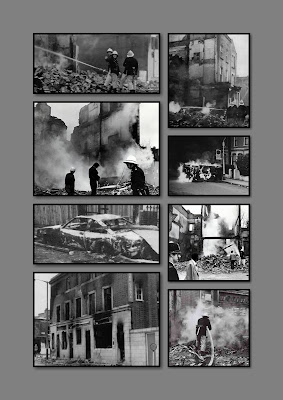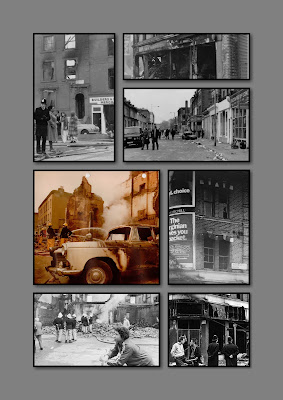BRIAN WILLIAM BUTLER, better known affectionately as ‘Bill’, was born in Brixton in the mid-1930s in the shadow of Brixton Prison. Whilst parts of Brixton reflected the relative affluence of a part of London that spoke of the grandeur of its former Victorian London heyday, with tall spacious terraced houses, wide streets and open spaces, he was raised in a compact backstreet terraced house. His childhood open spaces were those created by Adolf Hitler and his V1 and V2 rockets.
Well-grounded after attending the
nearby Clapham Secondary Central School, in his late teens he completed his
compulsory National Service having been selected to serve in the Grenadier
Guards, first performing public duties and then seeing active service in Egypt.
At the age of 20 he joined the London Fire Brigade and was trained at Lambeth,
the Brigade Headquarters, which was then the Brigade’s Training School.
His first posting was Clapham fire station, serving on the Red Watch.
Gifted with an intelligent mind he listened to, and learnt from, the advice
offered by the more experienced firemen who had served throughout the Blitz. He
then returned to Lambeth and became a member of its emergency tender crew. A
talented athlete he represented the Brigade, internationally, at Volley Ball. As
he honed his operational skills he rapidly gained promotion. At the relatively
young age of 28, and after only eight years’ operational service (a meteoric
rise in the early 1960s) he was promoted to Station Officer in charge of his
own watch. Following a brief spell in East London he returned to the newly
opened Divisional station at Clapham, frequently attending calls in the Brixton
area. His local knowledge, combined with a proven talent as a competent fire
officer, proved invaluable in those formative years and it would do so again.
With over ten years served in Station Officer rank, and as an outstanding
operational officer, promotion to senior officer rank was inevitable. It was,
however, a steady progression through the senior ranks, and one that saw him
gain valuable experience within Fire Prevention, later rebranded Fire Safety, and
operational training in London’s A Division, which covered the West End. In
1980 he again returned to Clapham only this time as the Divisional Commander
responsible for its eleven fire stations and the Fire Prevention department.
As a Deputy Assistant Chief Officer he had a wider operational role, one that
required him taking charge of major fires and other emergency incidents.
However, the Brixton Riots, in 1981, were totally unprecedented. There had been
skirmishes with stone-throwing youths attacking fire engines before, normally
on Bonfire Night, but nothing on the scale that was to unfold. There were no
published Fire Service rules of engagement or procedures when confronting a
riot. Brian Butler was about to change that. This is his story…
Saturday, April 11, 1981 and late on that fateful Saturday
afternoon the Brixton riots started. Their impact would have lasting
implications felt across the capital, and beyond. This subsequently brought
about both social change and much heated political debate. It certainly changed
the public’s perception of the Metropolitan Police and then its pervading
culture of racism that had, sadly, been demonstrated so forcibly by the
officers involved in dealing with black people in the build-up to the riot.
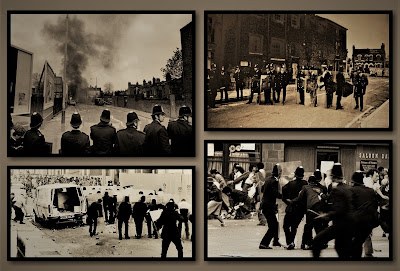 |
| The Metropolitan Police on the afternoon of April 11. |
During that Saturday morning Brixton fire station’s pump had been
driving through the very streets that would, all too soon, be illuminated by
the many fires that had been deliberately started. These would burn out of
control, destroying pubs, local shops, houses and numerous overturned cars. To
those riding Brixton’s fire engines that morning something was definitely in
the air. It was palpable. Lines of police ‘tactical support vehicles’ (transit
vans) were parked in the side roads around Railton, Mayall and Effra Roads. A strong
presence of uniformed policemen were everywhere. Many just standing on street
corners, looking tense, and waiting for something to happen.
A fierce exchange had taken place the previous evening, involving
the police and the young black men who frequented the private clubs and
backstreet bars of Railton Road. This exchange had resulted in a number of
arrests. Whilst the Station Officer at Brixton fire station had tried repeatedly
to speak to the duty officer at Brixton Police Station on that Saturday morning
trying to gain an assessment of a clearly tense situation, no information was
forthcoming. It had seemed obvious to those local firemen, as they had driven
around looking out from the safety of their fire engine, that all it needed was
another spark to ignite the blue touch paper. To them the police appeared more
than happy to supply the matches.
Having passed
on his concerns to the duty senior officer at B Divisional headquarters, the
Station Officer suggested that local stations be advised of the potential for
trouble around the Railton Road and Mayall Road area. The message came back at
1.30pm saying the police were of the opinion that no flare-ups were likely to
occur before nightfall. Clearly someone had spoken to the wrong policemen since
those in the locality were planning to get the action going long before then.
With Brixton’s Station Officer required to leave the fire station for a meeting
in the early afternoon it fell to his deputy, a Sub Officer, to take charge of
the station. However, unbeknown to the firemen at Brixton fire station rioting
had already broken out in the area of Railton Road and Atlantic Road in central
Brixton where police and black youths had clashed on Friday night. That
disturbance was soon stamped out but the trouble that Saturday evening, which
began after the arrest of a young black man, quickly spiralled out of control. So when other police officers arrived and
tried to make more arrests the ever-increasing crowd started throwing bottles
and bricks. Despite the strong police presence in the locality reinforcements
from other police areas were called in. In the 30 minutes it took for them to
arrive the violence had escalated sharply. A charge by about 200 police officers,
armed with plastic riot shields and batons, down Atlantic Road misfired. They
were forced to retreat under a hail of missiles.
At 5.30 p.m. Brixton’s fire crews got their first taste of a civil
disturbance. (So much for nothing until nightfall!) Ordered to a house fire in
Railton Road they never reached the incident. They were prevented from doing so
by brick throwing mobs involved in street to street fighting with the shield
wielding police officers. The mob filled Coldharbour Lane, Atlantic Road and
Railton Road. Brixton’s attempt to get a police escort to take their fire
engine towards the pall of smoke, clearly visible in the distance, failed. The
senior police officer present on the ground was not committing his officers and
told Brixton’s Sub Officer to forget it because of the volatile crowds and the
danger they posed.
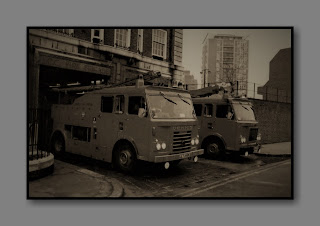 |
| Brixton fire station-Gresham Road. SW4. |
During the early stages of the riot West Norwood’s pump-escape had
been sent to a blazing car in Railton Road. As they approached the incident
from Brockwell Park a policemen waved the appliance through their cordon.
However, their route became increasingly congested by people spilling onto the
roadway. The Station Officer, Alan Lowles, had to order the driver of that
appliance to slow down. The crowd, that had until then been attacking the
police with bricks and stones, turned their hostility onto the approaching fire
engine. First the windscreen and side windows were quickly smashed and
missiles hit the firemen inside the cab. The driver, Fireman Michael Harding,
was concentrating on his driving and was unable to protect himself. He was hit
several times by brick-bats. One particular missile, a large lump of concrete,
hit him in the chest breaking two of his ribs and rupturing his spleen. Despite
his severe pain Harding continued to drive in accordance with the Station
Officer’s instructions. Reaching the Atlantic Avenue end of Railton Road, and
in the protection of the police again, the Station Officer summoned an
ambulance for Fireman Harding whilst his crew dealt with the severe vehicle
fire.
Brixton’s pump crew had by now been joined by the crew of West
Norwood’s pump-escape who had just made it down Railton Road. What was
happening to London Fire Brigade crews was a new and the unprecedented
experience. Unable to attend fire calls that some were ordered to they did not
know if lives were in danger or not. The situation in, and around, Railton
Road was deteriorating rapidly. Both firefighters and police officers alike
were in considerable danger from the constant hail of bricks, bottles and
sharpened lengths of wood being hurled at them by the hordes now gathering in large
numbers and charging at the police lines.
Unable to return to the local fire station, lest it be attacked,
Brixton and West Norwood crews were ordered to a temporary holding point, a
nearby coach station, just outside the immediate danger area. Widespread damage
and looting had by now spread as far as central Brixton. Brixton’s crews were
ordered by radio to attend further calls, including Burtons, the tailors, where
the looters had fired the shop as they left with their arms filled with their
spoils. By now other fire station crews were being ordered to the numerous 999
calls that the mobilising control at Croydon was receiving continuously. Fire
appliances become a legitimate target for their ferocious attacks.
The disturbance very quickly escalated into major proportions. News of the events in Brixton had spread via a cultural grapevine and others joined in the street violence having travelled in from surrounding areas. Several hundred members of the local community and the wider society added their weight and acted in an extremely riotous manner. Their number was to swell into the thousands. It was something that police, at this stage, were totally unable to contain. In fact these were the first serious riots of the 20th century and the first entailing substantial destruction of property since the formation of the Metropolitan Police.
The disturbance very quickly escalated into major proportions. News of the events in Brixton had spread via a cultural grapevine and others joined in the street violence having travelled in from surrounding areas. Several hundred members of the local community and the wider society added their weight and acted in an extremely riotous manner. Their number was to swell into the thousands. It was something that police, at this stage, were totally unable to contain. In fact these were the first serious riots of the 20th century and the first entailing substantial destruction of property since the formation of the Metropolitan Police.
Due
to the very pressure that the police were put under the level of protection
which could be afforded Brigade personnel and their equipment, whilst trying to
fight the fires started in this area of Brixton, was
minimal. Crews from various parts of London were called into the area and they
encountered previously unseen hostility. Hostility that caused the most severe
and difficult circumstances in addition to the normal hazards of fighting fire.
Fire engines were bombarded with missiles, crews targeted for attack from
bricks, masonry and bottles. Brigade equipment was sabotaged and even stolen
whilst in operational use!
As the evening moved into night the day shift crews were slowly
relieved and night watch crews took over. They faced a night of increasing
violence, running street battles and having to deal with several major fires
that were seriously under-resourced. This was the capital’s most serious public
disturbance in modern times. Radicals and extremists from various parts of
London were willing, and eager, to join in the violent assault on public order.
They were coming out of the ground like rats from Brixton and Stockwell tube
stations.
It was into this scene of chaos that Brian Butler, the local B Divisional
Commander, found himself projected. He already knew that the mobilising
control-room at Croydon was working under the most extreme pressure because of
the riots. He had been monitoring the radio traffic on his ‘listening post’
located in his office at Clapham. Booking ‘mobile’ he sped through Clapham’s
busy streets towards Brixton. He knew, in addition to the many fire crews
already on the ground, he had at his disposal his team of duty senior officers,
and he had access to more of each if required, but he soon realised that if
‘normal’ mobilising was maintained then fire engine crews would be sent
unwittingly into hostile areas. This would expose them to an extremely
dangerous and a volatile environment. On arrival he immediately took overall
command of the fire brigade actions and, more importantly, its mobilisation
within the area of the civil disorder. This was uncharted territory in Fire
Service operational tactics. Because of the number of fire engines in the
vicinity the Divisional control unit, based at Clapham, had already been sent
into the area and was located at the Effra Road ‘Orange’ coach station, which
itself was now in imminent danger of attack.
Despite the smaller riot in the Saint Paul’s district of Bristol,
in April 1980, and the attacks on Avon fire engines and their crews, no
national fire service advice or guidance had been published in respect of
dealing with such disturbances.
Brixton Prison is located on Brixton Hill. Whilst close to Brixton
town centre it was not in any immediate danger of attack from the rioters.
Access into the prison is via Jebb Avenue, a no through road. Brian Butler
choose this location as his forward command post. He set about establishing a
safe marshalling area for his appliances and crews. His were new operational
tactics and they were being developed on the hoof. It was the first time that
the deployment of a forward control point had been used in the British fire
service. His vast operational experience as a command officer, his intuitive
and decisive decision making, together with an intimate knowledge of the
affected area served to provide a comprehensive and effective plan of attack
that the fluid and rapidly changing situation demanded. He made sorties into
the area to make a personal assessment of the situation and ensured the best
use was made of his personnel and the resources available.
With the Divisional control unit relocated and designated a
“forward mobilising control” a number of appliances were held in readiness
under the command of a nominated senior officer who dispatched the appliances
into the riot zone. The control room at Croydon had been instructed not to
mobilise fire engines into the Brixton area but to refer all calls to the
forward mobilising control. Fire engine crews were fully briefed of the
prevailing situation and strict observance of the necessary changes to normal
firefighting techniques because of the very real threat posed to personnel by
the rioters.
Painting a
picture in words to anyone not directly involved in this situation, over those
prolonged fraught hours, is difficult if not impossible. This would be subsequently
deemed a major ‘civil disorder’. It was a breaking news story. It went global.
But not in todays terms of our instant 24 hour news coverage. The wider public woke
up to graphic images of the street violence, the aftermath of the destruction
that had erupted on South London streets. Sunday morning newspapers, the BBC
and ITV news bulletins covered the events in great detail.
Brian Butler was not the only one to face severe challenges that night. The acting Station Officer of Brixton’s Green Watch, Chris Giles, had to fight a most serious fire, involving a three storey public house, with only two fire engines and eight firemen. Something which in the normal course of events would have demanded eight fire engines plus special supporting crews. Needless to say the pub, which was well alight when the crews arrived, was a burnt out shell by the early hours of the Sunday morning. However the crews fought hard and successfully prevented the fire spreading to other adjoining property.
Brian Butler was not the only one to face severe challenges that night. The acting Station Officer of Brixton’s Green Watch, Chris Giles, had to fight a most serious fire, involving a three storey public house, with only two fire engines and eight firemen. Something which in the normal course of events would have demanded eight fire engines plus special supporting crews. Needless to say the pub, which was well alight when the crews arrived, was a burnt out shell by the early hours of the Sunday morning. However the crews fought hard and successfully prevented the fire spreading to other adjoining property.
Saturday night turned to Sunday morning. A massive police presence
was mobilised. Reinforcements, from all over London, arrived in Brixton.
Despite their weight in numbers the police tactics remained one of containment.
Something that those rioting on the streets took scant regard of as their
ferocious ‘hit and run’ attacks kept the police engaged and the fire brigade
crews under the ever present threat of serious harm from this wanton violence.
However, the plans put into action by Brian Butler were working and to good
effect. The fact that injury to fire brigade personnel was restricted to a
relatively small number was largely due to his presence of mind and his
leadership qualities.
By the early hours of Sunday morning it was possible for Brian
Butler to escort the Chief Fire Officer, Ron Bullers, to see for himself the
plans Brian Butler had put in place and to view the work of his firemen on the
ground. Both Brian Butler and the Chief were impressed, but not surprised, by
the highest possible commitment from members of the Brigade who had
demonstrated, in so many ways, the finest qualities required of a firemen.
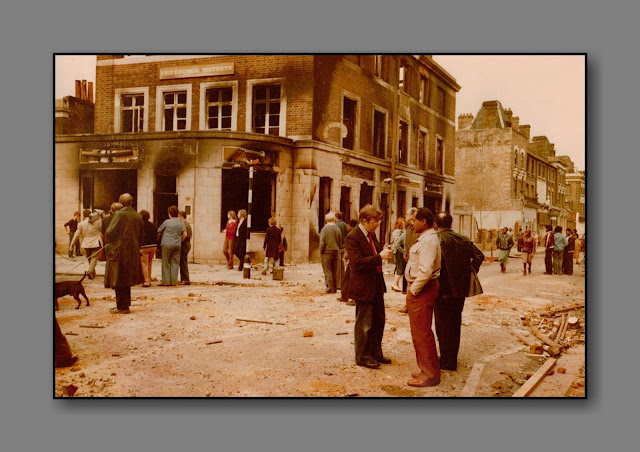 |
| Reporters gather information from the locals on Sunday morning, Sunday, April 12. |
By sunrise there was an uneasy calm. The forward command post was
closed down. It was not necessary to reinstate it again. The Metropolitan Police
flooded the area. Police officers, with what riot equipment the police had
available then maintained a discreet presence, sitting in police vans parked in
side streets. It was the traditionally clothed policeman that stood on the
street corners and, together with the Brixton locals, surveyed the scene of
considerable devastation that surrounded them.
That Sunday evening, and with high risk of more riots, Brian
Butler ordered the evacuation of Brixton fire station. It was not something the
crews at Brixton were happy about. But it was obvious that this was not an
issue for debate as far the Divisional Commander was concerned. Ten minutes
later the station was secured and empty! Brixton’s pump and driver headed off
to West Norwood fire station whilst the pump-ladder was driving towards Clapham
fire station. Brixton’s fire engines would cover its own ground from these adjoining
stations.
It was clear that fire engines remained a legitimate target as far
as the rioters were concerned. Hostility and aggression had started for a
second consecutive night, yet thankfully without the same level of destruction
that had taken place only twenty-four hours earlier. Sunday night the tension,
and running street battles, were confined to the rioters and the police who now
presented a massive presence in the affected area. None of the numerous arson
attacks that had materialised Saturday night were repeated.
Monday. Brixton’s night duty watch reported for duty at 6 p.m.
They expected the same evacuation drill as nightfall came. None came and they
remained at Brixton. Just before supper their first shout of the night was
received. It was to a house alight in Mayall Road, the heart of Saturday night’s
action. New tactics were now in place to ensure better crew safety in case of a
hostile attack. Driving as close to the incident as possible the drivers reversed
the fire engines down the cul de sac street to ensure a quick exit if
necessary. Working directly from the street hydrant the derelict house, which
was blazing merrily, was soon extinguished.
At 9.30 p.m both Brixton’s fire engines were ordered to a car
alight in Railton Road. They rapidly applied the tactics that Brian Butler had
insisted upon. The car was blazing fiercely as they approached. Stopping and
turning the appliances around, they reversed the last 150 yards towards the
incident. The street was illuminated by the light of the burning car. The air
heavy with the acrid smoke of burning rubber and the car’s interior. Water,
again used directly from the street hydrant, hit the burning car and the street
filled with clouds of steam as it made contact with the white hot metal of the
car. It burnt so fiercely that the car lay flat on the road surface, all its
tyres’ completely burnt away. There was no police escort despite their strong
presence. But these were not local Brixton policemen. They had little or no
knowledge of the area. Small groups of stone-throwing black and white youths
were playing cat and mouse with the policemen and causing a great deal of
confusion as they attacked, waited for the inevitable chase and then
disappeared down narrow alleys and pathways leaving the police increasingly
frustrated and angry.
That was the
last fire attributed to the Brixton riots. However, 14 Brigade personnel
sustained injuries from bricks and other missiles and eight fire engines and
one staff car were damaged. 299 police were injured, and at least 65 civilians
required hospital treatment. The triangular area most affected by the arson
attacks at the height of the rioting looked like a war zone. Damage to
buildings and property was on an unprecedented scale then for a ‘peacetime’ London.
Some of the
fires, that crews were prevented from attending, spread and involved other
surrounding premises. In one particular case five buildings were destroyed
after the initial blaze spread out of control. Some 61 private vehicles and 56
police vehicles were damaged or destroyed, mostly by fire. 28 premises were
burned down and another 117 damaged and looted. 82 arrests were made. Molotov
cocktails were thrown for the first time on mainland Britain. There had, until
then, been no such event in England in living memory.
Notes
1.
In 1981, Brixton’s Afro-Caribbean
community comprised roughly 25% of its population. It was an area of high
unemployment, particularly for black men, where rates were as high as 50%.
Brixton was also an area of high crime, and in that April the Metropolitan
Police initiated ‘Operation Swamp’. Within just six days, a massive police
presence on Brixton streets (including plain clothes officers) had led to
almost 1,000 people, mostly young black men, being stopped and searched. Police
operated then under the ‘sus’ law. In order to stop someone, a police officer
need only ‘sus’, or suspect that they might be intending to commit a crime. The
police were exempt from the Race Relations Act, and seemed to some to be
operating the ‘sus’ laws on the basis of racial prejudice.
Many found that the prevailing attitude
of so many police officers swamping the surrounding streets of central Brixton
made them feel increasingly uncomfortable. Police officers’ attitude towards
the black population was adversely impacting on the very public order task that
they were meant to be performing. It would later come to light that very many
were racist. They seemed to be itching for a fight with anyone of a skin colour
different from their own, which was universally white. This was not just a
local problem as they came from all over London, bussed into Brixton to police
the area while it slowly reverted to normal.
Black people, especially youths, were
more likely to be targeted and challenged in ways that would not be applied to
white people. In the days and weeks following the riots much was reported
nationally of the causes and implications of this civil unrest and the
disturbances in Brixton. But it would take future public inquiries to recognise
the ‘pernicious and institutional racism’ that prevailed throughout the
Metropolitan Police Force. The Stephen Lawrence inquiry conducted by Sir
William MacPherson and published in 1990 highlighted these very attitudes and
the ‘institutional’ racism that had been witnessed in 1981.
Following the Brixton riots Brian
Butler received many invitations to talk and comment on the lessons learned
that had tested not only him but those under his command. He spoke far and wide
and his actions set a new benchmark in the Fire Service response to civil
disturbances. The events of that April were not only unprecedented in the
history of the London Fire Brigade but the British Fire Service. It was
something that would not be repeated on such a scale for thirty years and the
widespread riots that erupted in 2011.
2. At the time of the Brixton riots
Fireman Harding had been a Brigade heavy goods driver for only two weeks.
Fireman Michael Harding and Station Officer Alan Lowles (West Norwood) were
awarded a Chief Officer’s Commendation and a Chief Officer’s Letter of
Congratulation respectively.
3. Fireman
Michael Harding was subsequently awarded the Queen’s Commendation for Brave
Conduct.
